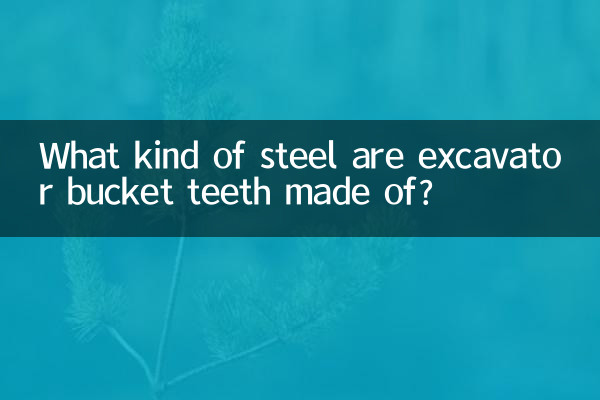What kind of steel are excavator bucket teeth made of?
Excavator bucket teeth are key wearing parts on excavators, and their material selection directly affects service life and operating efficiency. Recently, there has been a lot of discussion on the Internet about the material of excavator bucket teeth. In particular, steel types, performance comparisons and industry standards have attracted much attention. This article will combine the hot topics in the past 10 days to analyze the steel types and characteristics of excavator bucket teeth in the form of structured data.
1. Common steel types for excavator bucket teeth

According to industry data and user feedback, excavator bucket teeth mainly use the following steel types:
| Steel type | Main ingredients | Hardness(HRC) | Wear resistance | Applicable scenarios |
|---|---|---|---|---|
| High manganese steel | Mn 11%-14%, C 1.0%-1.4% | 18-22 | extremely high | Working conditions with heavy impact load |
| alloy steel | Cr 2%-5%, Mo 0.5%-1.5% | 45-52 | high | Moderate wear environment |
| low alloy steel | Mn 0.8%-1.2%, Si 0.5%-1.0% | 30-40 | medium | Light excavation work |
2. Recent hot topics of discussion
1.Work hardening properties of high manganese steel: Users are generally concerned about the increase in hardness of high manganese steel under impact load. Its surface hardness can rise to above HRC 50, but it requires reasonable heat treatment to exert its performance.
2.New composite bucket teeth: Some manufacturers have launched tungsten carbide + steel-based composite bucket teeth. The wear resistance is three times higher than that of traditional steel, but the cost is higher, which has become a hot spot in the industry recently.
3.Steel performance comparison test data: The measured data released by a construction machinery forum triggered heated discussions:
| test items | High manganese steel | alloy steel | low alloy steel |
|---|---|---|---|
| Average wear amount (g/hour) | 8.2 | 12.5 | 18.7 |
| Impact resistance (10,000 times) | ≥50 | 30-40 | 15-20 |
3. Things to note when purchasing bucket tooth steel
1.Working environment matching: It is recommended to use high manganese steel for hard soil layers such as granite, and alloy steel for soft materials such as clay.
2.cost benefit analysis: Although the unit price of high manganese steel bucket teeth is 30%-50% higher, the service life can be extended by 2-3 times, and the overall cost is lower.
3.Brand steel traceability: Recently, many incidents of fake and inferior bucket teeth have been exposed. It is recommended to choose a regular manufacturer that can provide material reports.
4. Industry technology development trends
1.Nano-reinforced steel: Refining the grains by adding Nb, V and other trace elements to improve the strength and toughness balance of steel.
2.Laser cladding technology: The wear-resistant alloy layer is coated on the parts of bucket teeth that are prone to wear to achieve local performance enhancement.
3.Intelligent material selection system: Some manufacturers have launched a material selection recommendation platform based on big data to automatically match the best steel type according to working conditions.
To sum up, the selection of excavator bucket tooth steel needs to comprehensively consider factors such as operating intensity, material characteristics and economy. With the advancement of material science, bucket tooth steel will develop in a composite and intelligent direction in the future, providing users with more efficient solutions.

check the details

check the details